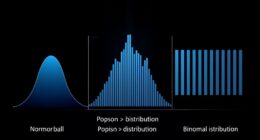When choosing sampling techniques like simple random, stratified, and cluster, you need to take into account your research goals and population. Simple random gives all individuals an equal chance, reducing bias and offering a quick snapshot. Stratified splits the population by key characteristics, ensuring important groups are represented. Cluster selects whole groups, saving time but potentially less precise. Keep exploring to understand which method best suits your study and how to apply each effectively.
Key Takeaways
- Simple random sampling gives all individuals an equal chance of selection, minimizing bias and providing a representative sample.
- Stratified sampling divides the population into subgroups based on characteristics, ensuring key segments are proportionally represented.
- Cluster sampling selects entire groups or clusters, which is efficient but may introduce more variability and less precision.
- Proper selection of sampling technique depends on research goals, population structure, and resource availability.
- Each method has unique advantages and limitations, impacting the accuracy, reliability, and generalizability of research findings.

Have you ever wondered how researchers choose which individuals to include in a study? The answer lies in the different sampling methods they use, which are an essential part of the research design. These methods determine how well your sample represents the larger population you’re studying, ultimately influencing the validity and generalizability of your findings. When planning your research, selecting the right sampling technique is crucial because it shapes the entire process, from data collection to analysis.
One common approach is simple random sampling, which gives everyone in the population an equal chance of being selected. Imagine you have a list of all potential participants, and you use a random process—like a lottery or computer-generated random numbers—to pick your sample. This method is straightforward, reduces bias, and is highly effective when you want a representative snapshot of the population. However, it requires a complete list of all members, which isn’t always feasible, especially with large or hard-to-reach populations.
Simple random sampling offers an unbiased way to select a representative sample from a population.
Another popular sampling method is stratified sampling, which involves dividing the population into subgroups or “strata” based on specific characteristics—such as age, gender, or income level. You then randomly select samples from each subgroup proportionally. This technique guarantees that key segments of the population are adequately represented in your study. Stratified sampling is especially useful when certain groups might be underrepresented or when you want to compare different segments within the population. It’s a more precise way to reflect diversity, but it requires detailed knowledge about the population structure and careful planning during the research design phase.
Cluster sampling is a different approach that’s often used when it’s difficult or costly to access individuals directly. Instead of sampling individuals, you randomly select entire groups or clusters—such as schools, neighborhoods, or companies—and include all members within those clusters in your study. This method can greatly save time and resources, especially in geographically dispersed populations. However, it can introduce more variability and less precision compared to simple or stratified sampling because clusters might differ from each other in ways that affect your results. Properly choosing and defining clusters is essential for reducing bias and ensuring your findings are meaningful.
Additionally, understanding the impact of sampling techniques on the accuracy and reliability of your results helps you make better research decisions. In essence, understanding these sampling methods helps you align your research design with your goals, resources, and the nature of your population. Each technique has its strengths and limitations, and selecting the appropriate one ensures your study produces reliable, valid results. Whether you’re aiming for a broad, general overview or a detailed analysis of specific groups, knowing how to choose and implement these sampling techniques makes all the difference in conducting effective research.
Frequently Asked Questions
How Do I Choose the Best Sampling Technique for My Study?
To select the best sampling technique, consider your study’s goals and the need to guarantee sampling bias is minimized. If you want to make certain every individual has an equal chance, simple random sampling works well. For better population representation, especially with diverse groups, stratified sampling is ideal. If your population is naturally divided into clusters, like neighborhoods, cluster sampling can be efficient. Match your method to your population and research needs for accurate results.
What Are Common Mistakes to Avoid in Sampling?
You can’t afford to overlook common mistakes in sampling! Avoid sampling bias at all costs—it’s like trying to hit a target blindfolded. Don’t ignore nonresponse error; it can skew your results more than you think. Always guarantee your sample truly represents your population, and double-check your methods. If you fall for these traps, your study’s accuracy will suffer, and you’ll end up with misleading conclusions.
Can These Sampling Methods Be Combined? if So, How?
Yes, you can combine sampling methods through sampling integration to improve accuracy. For example, you might use stratified sampling to guarantee representation across groups, then apply simple random sampling within each stratum. This approach helps reduce bias and increase efficiency. Just make sure your combined methods align with your research goals and that you clearly plan each step to avoid confusion or errors during implementation.
How Does Sample Size Affect the Accuracy of Results?
Your sample size directly impacts the accuracy of your results; larger samples tend to produce more reliable and precise outcomes. When you increase the sample size, you reduce sampling error, leading to more representative data. Conversely, a small sample size may cause results to be less accurate and more prone to variability. To improve result accuracy, you should carefully determine an appropriate sample size based on your study’s goals and population.
Are There Ethical Considerations in Sampling Processes?
Did you know over 50% of research studies face ethical issues? When you conduct sampling, you must consider ethics. You guarantee informed consent, so participants agree willingly. Protecting privacy concerns is essential to prevent harm or bias. Ethical considerations aren’t just formalities—they safeguard participants and enhance the study’s credibility. You’re responsible for maintaining honesty and transparency, making your research trustworthy and respectful of everyone involved.
Conclusion
In the end, choosing the right sampling technique depends on your research goals and resources. Whether you opt for simple random, stratified, or cluster sampling, each method has its strengths and pitfalls. Remember, not putting all your eggs in one basket can save you headaches later. So, weigh your options carefully and pick the technique that best suits your study—after all, a well-selected sample is the backbone of reliable results.









